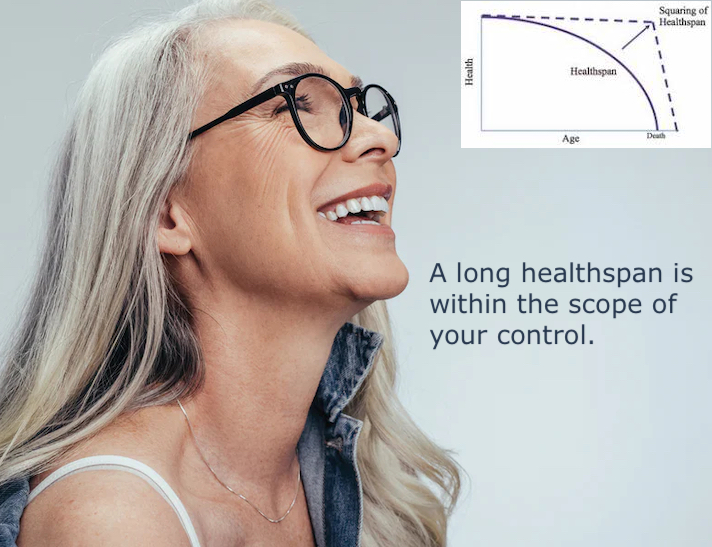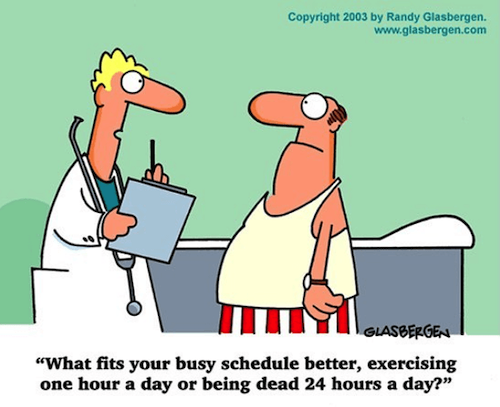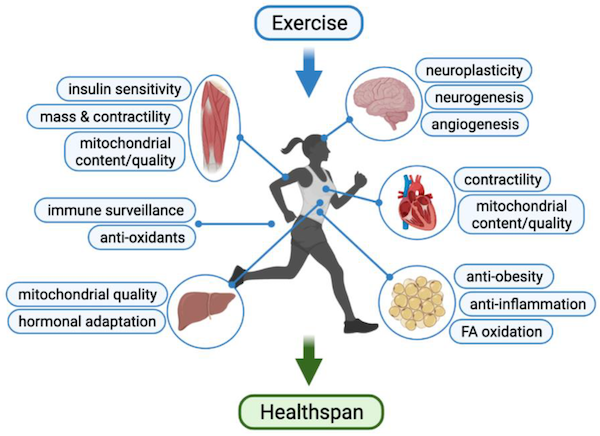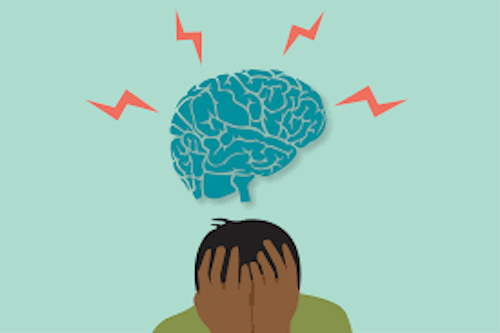Increase Your Healthspan By These Four Measures

Learn what to do to increase your healthspan, because the goal is to live long and strong, not to wither away. I cover cognitive decline, physical capacity, stress tolerance (homeostasis), purpose and intimacy.
You can increase your healthspan; it’s within the scope of your control. Lifespan? Not so much. But what has more value — to live a long time where you’re incapacitated the last decade or two, or to be healthy right up to the moment when you “kick the bucket”?
I choose healthspan, and I gather you do to, but this can’t be some wishful thinking. If you want to avoid the chronic diseases and infirmary that beset so many of us as get older, you must learn what to do, and then do it.
This is a longer post than usual, and it was inspired by a short but concise video by longevity expert Dr. Peter Attia, where he too focuses us on healthspan. Don’t miss that.
Here's what I cover in this post: Focus on healthspan, not lifespan Increase your healthspan by reducing the risk of cognitive decline Increase your healthspan by improving physical capacity Increase your healthspan by improving stress tolerance Increase your healthspan through purpose and intimacy
Let’s dive in…
Focus on Healthspan, Not lifespan
Lifespan is how long you live. Healthspan is how long you live in health. Few people would want to live till 100 years of age if the last 10 or 20 years would be experienced in pain and incapacitated. Most people, however, might want to live till 100 if they could reach that mark in relative good health.
There may not currently be much you can do to increase your lifespan, short of not dying early of some chronic disease, but there’s a lot you can do to live healthier, longer.
Unfortunately, as most people age, the incidence of chronic illness and incapacity increases, and this is particularly true in the last 10 years of life. This means that many of us do indeed wind up living many of our last years encumbered by disease and a low quality of life.
- More than half (51.8%) of adults had at least 1 of 10 selected diagnosed chronic conditions (arthritis, cancer, chronic obstructive pulmonary disease, coronary heart disease, current asthma, diabetes, hepatitis, hypertension, stroke, and weak or failing kidneys); and
- 27.2% of US adults had multiple chronic conditions.
Chronic illnesses such as cardiovascular disease, diabetes, cancer, and lung disease are some of the most common health issues that people experience in the last decade of life. These illnesses are often long-term and progressive, and, obviously, they can greatly diminish a person’s quality of life.
In addition to chronic illness, many older adults also experience a decline in physical and cognitive functioning, which can lead to increased incapacity. This can include issues such as difficulty walking, difficulty with activities of daily living, and difficulty with instrumental activities of daily living, such as managing finances, using the telephone, or cooking.
The onset of cognitive decline and dementia is also common in the last ten years of life. This can greatly impact a person’s ability to think and make decisions, as well as their ability to live independently.
Overall, as people age and approach the end of their lives, the incidence of chronic illness and incapacity increases, greatly impacting their quality of life. These issues often require the involvement of multiple healthcare providers, and can burden adult children.
As the saying goes:
Growing old ain’t for sissies.
But whether you’re a sissy or stoic, you’re going to get old. The question is, How functional will you be in old age?
How you experience old age is largely up to you. The 2021 Winter edition of the Harvard T.H. Chan School of Public Health Newsletter reports that we can greatly improve total life expectancy by engaging in healthier lifestyle, citing previous studies that indicated up to:
- 90% of diabetes,
- 80% of coronary heart disease,
- 70% of cardiovascular mortality, and
- 50% of cancer mortality could be avoided by adoption of healthy diets and lifestyles.
So, how might you increase your healthspan?
Conceptually, you have to adopt lifestyle factors that will bend your age curve.
As the graph below indicates by the green line, as we age there’s a decline in overall health that starts out slow, but gets progressively faster as we approach the outer bounds of average human lifespan. What you want to do is to increase the years over which you’re healthy, as depicted by the red line.
Bend Your Age Curve

Longevity expert and physician Dr. Peter Attia encourages us to focus on healthspan in the video below. The focus, he says, should be to “compress the period of decline”; meaning, to endeavor not to spend the last years of your life getting sicker and sicker as you slowly march to death. Rather than that, choose Jack LaLanne’s path — he died at age 96, and was still exercising regularly up to the last week before he passed.
So, how do you push that green curve out and make it red; in other words, how do you slow the rate of decline due to aging?
Well, as I indicate on the y-axis of my “Bend Your Age Curve” graph, you need to make lifestyle choices to enhance your:
- Cognitive ability — Maintain neurological health.
- Physical capacity — Keep joints able to perform under load over their full range of motion; to keep your cardiovascular system able to support both aerotic and anaerobic xxx; and to keep your muscles strong.
- Stress tolerance — Maintain physiological homeostasis in the face of various physiological, mental and immune stresses.
- Purpose and support — Have a reason to get up in the morning and apply yourself to achieving something with the support of others, preferably some with whom you have intimacy.
Let’s address each of these four health parameters within the context of extending healthspan. I’ll describe how the aging process diminishes them, and what you can do to push back in order to live a longer and stronger life.
1. Increase Your Healthspan by Reducing the Risk of Cognitive Decline
Cognition is the mental action or process of acquiring knowledge and understanding through thought, experience, and the senses. Cognitive disorders are a part of the neurocognitive disorder classification, which includes:
- Dementia (including Alzheimer’s)
- Developmental disorders
- Motor skill disorders
- Amnesia
- Substance-induced cognitive impairment
Aging can have various neurological impacts, including changes in cognitive function, an increased risk of neurodegenerative diseases, and changes in the structure and function of the brain.
Some of the specific changes that can occur as a person ages include a decline in memory and processing speed, an increased risk of diseases such as Alzheimer’s and Parkinson’s, and changes in the structure and function of nerve cells. Additionally, the risk of stroke and other brain injuries also increases with age.
It’s important to note that these impacts can vary greatly from person to person, and that healthy lifestyle choices can help to mitigate some of the negative effects of aging on the brain. I want to briefly touch on three such mitigation factors:
- Supplements,
- Exercise, and
- The gut microbiome.
Supplements can contribute to mental health
Various categories of supplements can play a part in keeping your brain working as you age, such as:
- Neuroprotective herbs,
- Nootropics, and
- Phytochemical-based supplements.
I get into the details about the usefulness of these supplements in my post, How You Can Beat Dementia and Build A Bullet-proof Brain, but I’ll touch on some highlights below. Do your homework before you pile into supplements. Talk to your doctor and/or refer to the excellent summaries of relevant studies available on the website Examine.com.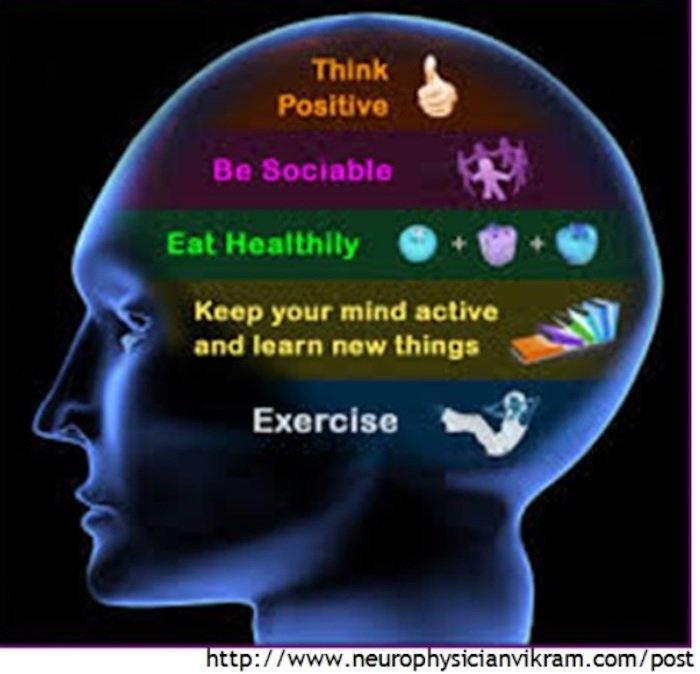
Nueroprotective herbal products contain complicated mixtures of organic chemicals, which may include fatty acids, sterols, alkaloids, flavonoids, glycosides, saponins, tannins, terpenes and so forth. Four you should know about are:
Nootropics is a term used by proponents of “smart drugs” to describe medical drugs and nutritional supplements that have a positive effect on brain function.
There’s a bewilderingly large amount of nootropics available over-the-counter, but perhaps you could first check out the the Ciltep Nootropic Stack recommended by Dave Asprey (the “Bullet-proof Executive”) and Tim Ferriss (big-time podcaster).
Phytochemicals from medicinal plants and herbs play a vital role in maintaining the brain’s chemical balance and to treat cognitive disorders, says Professor G. Phani Kumar in his publication, Neuroprotective potential of phytochemicals.
Five supplements in this category you might consider are:
- Sulforaphane
- St. John’s Wart
- Curcumin
- Trans-resveratrol or Pterostilbene (Note: see this update)
- Garlic
Again, get the details about the aforementioned supplements here.
Exercise can lower the risk of overall cognitive decline
Susan Krauss Whitbourne, Ph.D., is a professor of Psychological and Brain Sciences at the University of Massachusetts Amherst. In her book, The Search for Fulfillment: Revolutionary New Research That Reveals the Secret to Long-term Happiness, she reviews six reasons to exercise for the brain.
#1 Exercise lowers dementia risk through the increase in blood flow, preserving brain neurons, and possibly by improving your glucose and fat metabolism.
#2 Exercise lowers anxiety by increasing endorphins and refocusing attention away from anxiety-inducing situations.
#3 Exercise can be fun which is its own reward, including those endorphins.
#4 Exercise boosts memory by helping your neurons stay in shape, particularly in the memory areas of your brain.
#5 Exercise builds intelligence because as oxygen flows more freely to your brain, not only does your hippocampus benefit but so does the part of your brain involved in planning and reasoning (the prefrontal cortex).
#6 Exercise is a great mood enhancer, again, by causing your body’s endorphins to kick in. These are the natural “feel good” neurotransmitters that start to exert their effects after about 20 minutes of training.
Beneficial microbes can protect your brain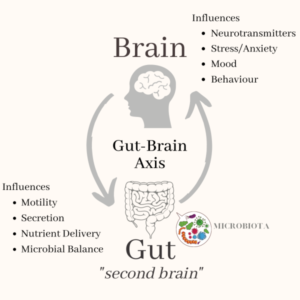
Yes, it’s strange to assert that those single-cell microbes in your gut can have a big impact on your brain, but that’s what hundreds of studies have shown.
A just-published study (Dec. 2022) by Cambridge University Press entitled, The gut microbiota is an emerging target for improving brain health during ageing, presents recent evidence that gut microbiota may be a potential target to improve symptoms of brain aging and promote healthy cognition.
A study published in 2020 (summary) by a group of scientists in Geneva, Switzerland confirmed the link between Alzheimer’s and gut microbiota. I don’t have access to the full report, but I found a review of it.
I could go on and on citing study after study that shows the connection between the brain and the gut. Suffice to say that you need to feed the beneficial bacteria in your gut and starve the rest. The simplest way to do this is to eat fiber-rich and fermented foods, and supplement with a good probiotic.
To help guide the way, check out these posts:
- Test Your Gut Health — Here’s How
- How To Heal Your Aging Gut Microbiome
- How The Right Gut Bacteria Benefits Your Health and Longevity
2. Increase Your Healthspan by Improving Physical Capacity
You just read about how exercise benefits cognitive function, but there’s a whole lot more that it does to increase your healthspan.
You want to focus on three pillars of physical capacity:
- Mobility,
- Cardiorespiratory fitness, and
- Strength.
Mobility refers to the full range of joint movement under load. The “under load” refers to how your joints react to the stress of weight. For instance, your knees might be fine when walking, but if you were to squat low with something heavy in your hands, could they handle that?
Read The Functionally Fit Fast Workout — Warm Up and Mobility.
Cardiorespiratory fitness refers to both anaerobic (sprinting) and aerobic conditioning (jogging). You want to be able to do short spurts of (nearly) all-out effort, as well as sustained, steady state effort.
Read:
- Forget Aerobics — Burn Your Fat with Metabolic Circuits
- An Aerobic Hike Up Mt Rainier
- A 7-minute Exercise Snack You Can Do At Home
Strength, like everything else in the physical realm, is relative. From the perspective of healthspan and aging, you want to have enough strength to move your body around. And for that you have to slow down the wicked muscle-wasting phenomenon called “sarcopenia”.
No matter your age, you can benefit from strength training, whether it’s calisthenics whereby your using your own weight, or weight lifting.
If you’ve never done this sort of exercise, and you’re past 50 years of age, I highly recommend hiring a trainer so you learn what to do, how much to do, when to do it, the proper form, etc. For inspiration, check out my posts:
- Get Strong and Live long with Strength Training
- The Many Benefits of Strength Training… Even For You, Graybeard
- Get Stronger as You Age — Why and How
3. Increase Your Healthspan by Improving Stress Tolerance
Stress can mean a lot of things, such as:
- Anxiety
- Peer pressure
- Work pressure
- Physiological instability
One way to look at stress in all its manifestations is through the lens of “homeostasis“, which is the balance among all the body systems needed for the body to survive and function correctly.
Overall, human aging is associated with a decline in physiological homeostasis, which can lead to an increased risk of disease and a decline in overall health.
Here are a few examples:
Body temperature regulation: The hypothalamus in the brain monitors the body’s temperature and sends signals to the body to increase or decrease heat production and loss to maintain a stable internal temperature.
Blood glucose regulation: The pancreas releases insulin to lower blood glucose levels and glucagon to raise them, keeping blood sugar levels within a healthy range.
Blood pressure regulation: The kidneys, heart and blood vessels work together to control the amount of blood flow and the constriction or dilation of blood vessels to maintain a consistent blood pressure.
Acid-base balance: The lungs and kidneys work together to regulate the pH of the blood by eliminating or retaining acids or bases.
Fluid balance: The kidneys, sweat glands and hormones regulate the balance of fluids in the body, keeping the body hydrated and preventing dehydration.
Human aging is associated with a decline in physiological homeostasis, which is the ability of the body to maintain a stable internal environment. As we age, our body’s systems begin to malfunction and lose efficiency, resulting in an increased risk of disease and a decline in overall health.
One of the most notable changes that occur with aging is a decline in the body’s ability to regulate temperature. The hypothalamus, which is responsible for regulating body temperature, becomes less responsive as we age, which can lead to an increased risk of hypothermia in older adults.
Another key area of decline is blood glucose regulation. With aging, the pancreas becomes less able to produce insulin, which is necessary to regulate blood sugar levels. This can lead to an increased risk of diabetes in older adults.
In addition, blood pressure regulation also becomes less efficient as we age. The walls of blood vessels become stiffer and less elastic, which makes it more difficult for the heart to pump blood. This can lead to an increased risk of hypertension and cardiovascular disease.
The body’s acid-base balance also tends to decline with age. The kidneys, which play a crucial role in regulating the pH of the blood, become less efficient at removing acids and bases, which can lead to an increased risk of acidosis.
Finally, fluid balance also tends to decline with age. The kidneys, which play a crucial role in regulating the balance of fluids in the body, become less efficient at removing excess fluids, which can lead to an increased risk of edema.
So, what can you do about all this, which is to say, How can you maintain resilence in the face of stress in order to maintain homeostasis?
Three things can help:
- Be mindful of what makes you emotionally, psychologically stressed;
- Meditate; and
- Exercise.
We’ve covered exercise, so let’s take a look at mindfulness and meditation.
Mindfulness
I think that the simplest way to get a handle on mindfulness is to be present in whatever you’re doing. That means not thinking about something else other than whatever your doing at the moment.
Three ways to stay present are:
- Do one thing at a time
- Make sure your mind and body are in the same place at the same time
- Take on breath
Try this: Set your phone alarm to ring every hour, and when it does, check in with yourself and see where your mind is. Is it on task? Is it worrying about something? Is your body tight and your breathing short?
Take a breath — deep inhale through the nose for a count of four, hold four, exhale four. Repeat if necessary.
Meditation
Meditation can be a long bout of mindfulness — rather than a momentary “checking in”, typically you set aside a time and place, sit down or lie down and get to it. 
But what exactly are you getting to?
That depends on what you want out of your meditation and what technique you might be using. You could try to focus on a blank slate where no thoughts intrude, or focus on a symbol, or repeat a mantra, or create a movie-like experience of what you want to experience.
What you “do” while meditating is up to you, but the one thing common to all meditation is focus. You endeavor to bring your attention to whatever it is you’re meditating on, and try not to let your mind wander. Of course, your mind will wander. When that happens, gently let the wandering go and return your attention to your meditation.
One great way to help you get deeper into your meditation is through brain entrainment. These sounds help your brain waves produces the alpha and theta waves predominant when meditating.
See these posts:
4. Increase Your Healthspan through Purpose and Intimacy
A sense of purpose and intimacy have been linked to improved healthspan for several reasons.
A sense of purpose, or having goals and objectives that give one’s life meaning, can lead to a greater sense of self-worth and self-esteem, which in turn can lead to better overall mental and physical health.
Intimacy, or having close and meaningful relationships with others, can also have a positive impact on healthspan. Studies have shown that people who have strong social connections and supportive relationships tend to have lower levels of stress and depression, and may also have better overall physical health. Additionally, intimacy can provide a sense of social support, which can be especially important as people age and may become more dependent on others for assistance with daily activities.
Having purpose and intimacy was a common theme among all the Blue Zones where the inhabitants tend to live longer and healthier than people in the rest of the world. As I wrote in Reverse Engineer Longevity — Three Ways Your Environment Creates A Long and Strong Life:
Blue Zoners have close friendships that last a lifetime, interact with them almost daily, all within the context of a “sense of purpose”.
If you’re spending too much time alone, reach out to a few people you haven’t seen for awhile and get some activities going with them. And if you’re waking up each morning wondering what to do with yourself, try to remember what got you excited when you were younger. Perhaps it’s time to devote yourself to learning or doing something that you never had the chance to explore.
And that’s it for now.
If you’re not a Subscriber, check out this page and get on board!
Last Updated on January 21, 2023 by Joe Garma

